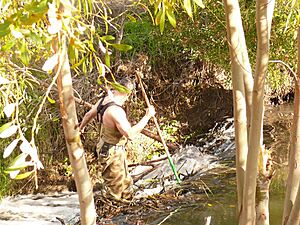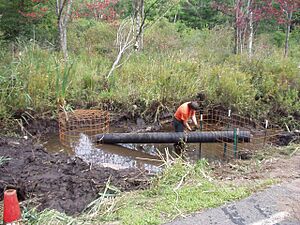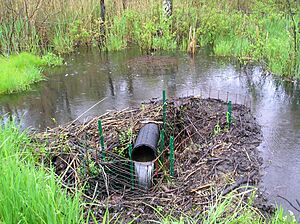Flow device facts for kids
Flow devices or beaver deceivers are special tools that help solve flooding problems caused by beavers. Beavers are amazing builders, but sometimes their dams can block water flow and cause floods near roads or homes. For a long time, people would trap and remove beavers to stop flooding. But this often didn't work for very long. New beavers would quickly move into the area and build new dams.
Flow devices are a better solution. They are human-made systems that control water levels around beaver dams and keep pipes (called culverts) clear. These devices are usually cheaper to install and don't need much looking after. They help prevent floods while letting beavers stay in their homes. Studies have shown that using flow devices can save a lot of money compared to constantly removing beavers or repairing flood damage.
Contents
Why Beavers are Good for Nature


Beavers were once almost gone from North America because of too much trapping. When they disappeared, many streams and rivers started to dry up. This caused a lot of harm to the environment.
Beavers are super important for nature because they:
- Create Wetlands: Their dams create wetlands. These are special areas full of water that are home to many different plants and animals.
- Clean Water: Wetlands help clean water by removing dirt and pollution.
- Stop Fires: Beaver ponds can act like fire breaks, slowing down wildfires.
- Help Fish: Fish like salmon and trout can easily cross beaver dams. In fact, fish often grow bigger and there are more of them when beavers are around!
- Support Other Animals: Beavers are a "keystone species." This means they create habitats that many other animals need to survive. For example, when beavers built ponds in Alhambra Creek in Martinez, California, many birds, steelhead trout, river otters, and mink returned to the area.
The most common problems beavers cause for people are blocked road culverts or large beaver dams. These issues can usually be fixed with well-designed flow devices. These clever tools help us keep the good things beavers do for nature, like creating wetlands and helping fish, without causing floods.
How Flow Devices Were Invented
People have been trying to find ways to manage beaver dams for a long time.
- In 1952, the idea of putting pipes through dams to control water levels was first talked about.
- By 1963, the New Hampshire Fish and Game Department had already put pipes in 46 dams with good results.
- In 1978, the New York State Department of Environmental Conservation started testing different ways to protect culverts. They found that a "T-culvert guard" worked best.
- In 1992, Clemson University created the Clemson Beaver Pond Leveler. This device used a special pipe system to guide water through dams.
Over the years, these designs have been made even better. The newest flow devices often combine fences with pipe systems. These smart designs trick beavers and keep water flowing where it should.
Modern Flow Devices
Beaver Dam Pipes
Beavers are very good at plugging up any leaks in their dams. They do this because they need the deep water in their pond to stay safe. If a beaver can hear or feel water flowing into a pipe, it will quickly try to block it with mud and sticks.
To work well, a beaver dam pipe must hide the sound and feel of the water flowing into it. Successful pipe designs, like the Flexible Pond Leveler or Clemson Pond Leveler, do this by putting a fence around the pipe's opening. A beaver swimming nearby won't hear or feel the water going into the pipe. This means they won't try to block it.
The height of the pipe in the dam controls the water level of the pond. Beavers rely on water for safety. If a pond is lowered too much, beavers might try to build a new dam to raise the water level again. Also, lowering the water too much can shrink valuable wetlands. So, it's important to only lower the pond enough to solve the flooding problem.
Protecting Culverts
A culvert is a large pipe that goes under a road. Beavers often try to block these pipes because the fast-moving water can feel like a hole in a dam. With a little work, a beaver can quickly plug a culvert. This can turn the road into a big dam and cause floods. Road crews often spend a lot of time and money clearing beaver dams from culverts.
Culvert Protective Fences
The Beaver Deceiver is a special fence shaped like a trapezoid. It was invented in the 1990s by Skip Lisle. This fence is very good at stopping beavers from blocking culverts.
It works in three main ways:
- Too Big to Dam: The fence is usually 40 to 50 feet long. This makes it too big for a beaver to dam the whole thing.
- Wrong Direction: The fence forces beavers to build their dam away from the culvert. This is not how they naturally build, so they often give up.
- Less Water Sound: As beavers try to dam further out on the fence, the stream opening gets wider. This makes the sound and feel of moving water less noticeable, which discourages them. If the sides of the fence are at least 12 feet long, beavers usually leave it alone.
For a culvert fence to work, it needs to be surrounded by enough water. This makes it harder for beavers to go around it. Since beavers are great at digging, a fence floor is often needed to stop them from tunneling underneath. The fence walls only need to be about 24 inches above the water. Beavers don't climb, so this height is enough.
Fence and Pipe Culvert System
Another good way to protect culverts is to combine a small culvert fence with a Pond Leveler Pipe. The small fence encourages beavers to build a dam on it. But the Pond Leveler Pipe, installed through the fence, stops the water from rising too high.
This system needs very little maintenance. It controls where and how high beavers can build their dams. For this system to work best, the pipe's opening should usually be in at least 3 feet of water. If the water isn't that deep, a simple Culvert Protective Fence might be a better choice.




